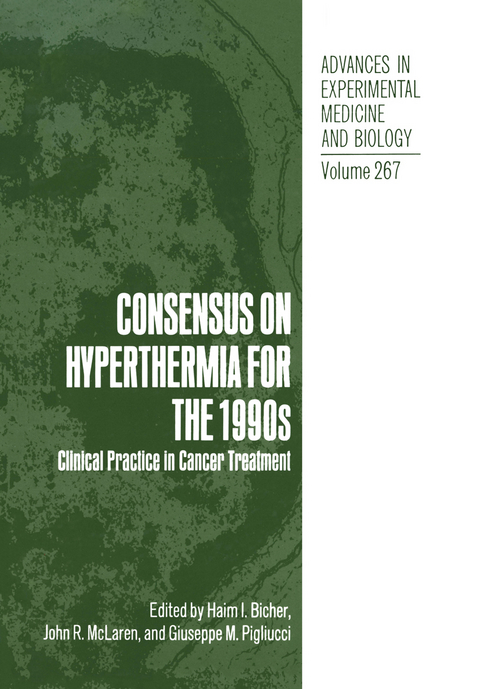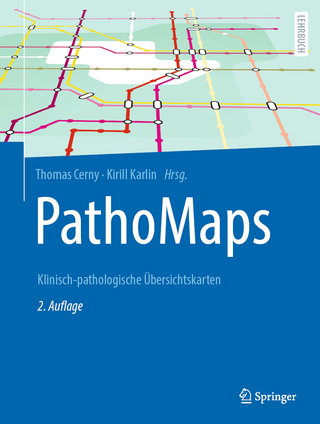
Consensus on Hyperthermia for the 1990s
Springer-Verlag New York Inc.
978-1-4684-5768-1 (ISBN)
Chapters.- Clinical Use of Regional Hyperthermia.- The Basis for Hyperthermia Becoming the 4th Cancer Treatment Modality.- Local Tumor Hyperthermia in the 1990s.- Consensus of Hyperthermia for the 1990s.- Micronuclei Assay-A Predictive Variable for Tumor Response to Treatment.- Instrumentation for Clinical Hyperthermia.- The Use of Hyperthermia in Cancer Treatment Thermotron RF-8.- Heat Shock Proteins.- Biochemical and Ultrastructural Changes in the Hyperthermic Treatment of Tumor Cells.- Interstitial Hyperthermia: Technical Problems and Methodology.- Conductive Interstitial Hyperthermia: A New Modality for Treatment of Intracranial Tumors.- Hyperthermia for the Treatment of Brain Tumors.- Hyperthermia and the Liver.- Quality Control of a Hyperthermia System.- Use of Local Hyperthermia for the Treatment of Benign Hyperplasia.- Extracorporeally Induced Total Body Hyperthermia for Disseminated Cancer.- Radiant Heat Systemic Hyperthermia Clinical Trials.- Whole Body Hyperthermia and Intraperitoneal Carboplatin in Residual Ovarian Cancer.- Overview of Whole Body Hyperthermia Experience at American International Hospital.- Hyperthermia and Chemotherapy.- Treating Advanced Melanoma with Hyperthermia in a Private Surgical Oncology Practice.- The Role of Hyperthermic Perfusion in the Treatment of Tumors of the Extremities.- Development of an Electrical Impedance Tomography System for Noninvasive Temperature Monitoring of Hyperthermia Treatment.- The Role of Paramedical Personnel in the Field of Clinical Hyperthermia: Past, Present, Future.- Procedures for Improving Therapeutic Gain.- Biological Response to Heat.- Perspectives and Hopes for the 1990s.- Papers.- Control of the Physical Parameters in Local Electromagnetic Hyperthermia.- Experimental Use of Extensive Pre-cooling ofSubcutaneous Fatty Tissue in Radiofrequency Capacitive Heating.- Four Element Computer Controlled 432 MHZ Phased Array Hyperthermia System.- Results of Deep Body Hyperthermia with Large Waveguide Radiators.- Superficial and Intraurethral Applicators for Microwave Hyperthermia.- Tripas: A Triple Applicator System with Relocatable “Hot Spot” at Tissue Depth.- Noninvasive Measurements in Hyperthermia: Radiometry and Previsional Thermometry.- Local Hyperthermia for Superficial and Moderately Deep Tumors-Factors Affecting Response.- Ultrasound and the Blood-Brain Barrier.- Clinical Experience with Local Hyperthermia in Rotterdam.- Whole Body Hyperthermia Experience in Breast Cancer at American International Hospital.- New Clinical Aspects of Whole Body Hyperthermia.- Thermal Induction and Temperature Control in the Hyperthermic Antiblastic Regional Perfusion with Extracorporeal Circulation.- Centered Radio-frequency Hyperthermia in Solid Tumors.- Local Hyperthermia for Deep Tumors.- Thermoradiotherapy of Deep Seated Tumors of the Pelvis with the APA and Sigma Applicator.- Intracavitary Hyperthermia Combined with HDR After Loading Irradiation in Vaginal Recurrences of Cervical Carcinoma.- Local Microwave Hyperthermia and Benign Prostatic Hyperplasia Induced Bladder Outlet Obstruction.- Thermoradiotherapy of Pelvic Tumors with the BSD 2000.- Radiosensitizing Effect of Hyperthermia in Radioresistant Tumors.- Hyperthermia and Hyperglycemia in Tumor Therapy.- Enhancing Thermoradiotherapy Efficacy by Hyperglycemia.- Influence of Hyperthermia on Experimental Viral Infections in Vitro.- Immunotherapeutical Strategies in Cancer Patients.- Coley Toxins — The First Century.- Generation of Non MHC Restricted Cytotoxic Immune Responses: Effects of “in Vitro” HyperthermicTreatment.- Responses of Immune System to Hyperthermia.- Perspectives for the Combined Use of Photodynamic Therapy and Hyperthermia in the Cancer Patient.- Assessment of Combined Thermoradiotherapy in Recurrent Advanced Carcinoma of the Breast.- Local Hyperthermia for Treatment of Advanced Prostatic Carcinoma.- An Overview of the Role of Radiation Therapy and Hyperthermia in Treatment of Malignant Melanoma.- Clinical Relevance of Heat Shock Proteins.
| Reihe/Serie | Advances in Experimental Medicine and Biology ; 267 |
|---|---|
| Zusatzinfo | 572 p. |
| Verlagsort | New York, NY |
| Sprache | englisch |
| Maße | 178 x 254 mm |
| Themenwelt | Sachbuch/Ratgeber ► Natur / Technik ► Garten |
| Medizin / Pharmazie ► Medizinische Fachgebiete ► Onkologie | |
| Studium ► 2. Studienabschnitt (Klinik) ► Pathologie | |
| Naturwissenschaften ► Biologie ► Zoologie | |
| Naturwissenschaften ► Physik / Astronomie ► Angewandte Physik | |
| ISBN-10 | 1-4684-5768-3 / 1468457683 |
| ISBN-13 | 978-1-4684-5768-1 / 9781468457681 |
| Zustand | Neuware |
| Haben Sie eine Frage zum Produkt? |
aus dem Bereich


